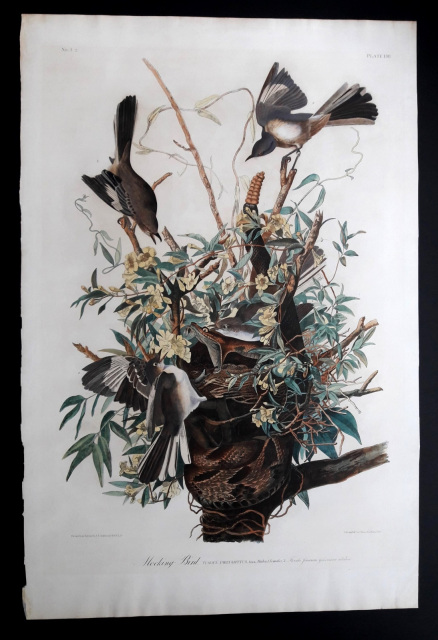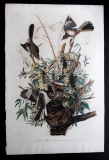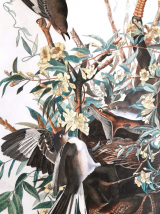- Home
- >
- Audubon's Bien Edition Birds (19th Century)
- >
- 138 - Mocking Bird
138 - Mocking Bird
SKU:
BE-138
$18,500.00
$15,000.00
$15,000.00
Unavailable
per item
Audubon's Bien Edition Chromolithograph of "Mocking Bird" (full sheet with wide margins).
A truly quintessential Audubon painting ! Audubon started working on this magnificent image in 1821 during his stay at the Oakley Plantation in St. Francisville, Louisiana, and completed it a few years later. This is a superb example of how Audubon distinguished himself from all other artists of his era - - by painting live drama in Nature, and in true scale. It shows the Mocking Bird parents trying to protect and defend their eggs against a vicious rattle snake, with two additional birds joining them in the fight against the unwelcome intruder.
When Audubon painted this image, he drew considerable ridicule and even vicious criticism questioning the depiction of a rattle snake up in the tree (including, ridicule from George Ord, of the Academy of Natural Sciences of Philadelphia and a devout friend of Alexander Wilson (see William Souder's book, "Under a Wild Sky" for an account of some of the ridicule that poor Audubon had to put up with). It would appear that George Ord swore that he would prevent the French-American immigrant with thick French accent and long hair, viz., John James Audubon, from besting his good friend Alexander Wilson). This unfair criticism of Audubon and of his painting is now discredited because, shortly after Audubon painted this image and attracted considerable criticism, reports started pouring in about rattle snakes climbing trees to prey upon bird nests ! (e.g., see the YouTube for more recent sightings of rattle snakes up in trees).
The Mocking Bird is the State Bird of Arkansas, Florida, Texas, Tennessee and Mississippi.
Audubon was truly captivated by the Mocking Bird and its ability to mimic the musical calls of other birds. He wrote " They are not the soft sounds of the flute or of the hautboy that I hear, but the sweeter notes of Nature's own music. The mellowness of the song, the varied modulations and gradations, the extent of its compass, the great brilliancy of execution, are unrivalled. There is probably no bird in the world that possesses all the musical qualifications of this king of song, who has derived all from Nature's self. Yes, reader, all! "
A truly quintessential Audubon painting ! Audubon started working on this magnificent image in 1821 during his stay at the Oakley Plantation in St. Francisville, Louisiana, and completed it a few years later. This is a superb example of how Audubon distinguished himself from all other artists of his era - - by painting live drama in Nature, and in true scale. It shows the Mocking Bird parents trying to protect and defend their eggs against a vicious rattle snake, with two additional birds joining them in the fight against the unwelcome intruder.
When Audubon painted this image, he drew considerable ridicule and even vicious criticism questioning the depiction of a rattle snake up in the tree (including, ridicule from George Ord, of the Academy of Natural Sciences of Philadelphia and a devout friend of Alexander Wilson (see William Souder's book, "Under a Wild Sky" for an account of some of the ridicule that poor Audubon had to put up with). It would appear that George Ord swore that he would prevent the French-American immigrant with thick French accent and long hair, viz., John James Audubon, from besting his good friend Alexander Wilson). This unfair criticism of Audubon and of his painting is now discredited because, shortly after Audubon painted this image and attracted considerable criticism, reports started pouring in about rattle snakes climbing trees to prey upon bird nests ! (e.g., see the YouTube for more recent sightings of rattle snakes up in trees).
The Mocking Bird is the State Bird of Arkansas, Florida, Texas, Tennessee and Mississippi.
Audubon was truly captivated by the Mocking Bird and its ability to mimic the musical calls of other birds. He wrote " They are not the soft sounds of the flute or of the hautboy that I hear, but the sweeter notes of Nature's own music. The mellowness of the song, the varied modulations and gradations, the extent of its compass, the great brilliancy of execution, are unrivalled. There is probably no bird in the world that possesses all the musical qualifications of this king of song, who has derived all from Nature's self. Yes, reader, all! "
138 - Mocking Bird
Chromolithograph
Bien Edition, Birds of America
The Bien edition prints of the Birds of America were produced by the Audubon family (by Audubon’s sons John Woodhouse and Victor Gifford), and thus are properly termed originals. Unlike the Havell edition prints which were produced in England, the Bien Edition prints were produced completely in America. Thus, they are truly American originals. In 1858, about seven years after John James Audubon passed away, his younger son John Woodhouse Audubon initiated an ambitious project to reissue the Birds of America to solve some of the mounting financial problems. He recruited the Roe Lockwood Company in New York city to publish the works and Julius Bien for lithography. Unlike the Havells which were produced from copper engraving plates, Julius Bien utilized the newly emerging chromolithography process as a way of reducing the costs of production. Chromolithography utilized a set of printing stones (about 6 or more, carrying images transferred from the original copper-plate engravings), each with different color printed in register to layer the colors to produce the final colored image on paper. Some of the final prints were hand-colored in specific areas to enhance the image. The use of different stones occasionally resulted in very slight misregister of colors on the dark outlines of birds and background, thus serving as a charming reminder of chromolithography process. Larger images were printed on a single page as in the Havell edition, whereas smaller images were printed two per page. All the larger images as well as some smaller images carry the credit "Chromolithy by J. Bien, New York, 1860” (but some with years between 1858 to 1862). Thus these images are commonly referred to as the Bien edition plates. Unfortunately, the start of the Civil War in 1860 brought an abrupt end to this project (and a financial ruin to the Audubon family) after only about 105 pages were printed. It was said that about 100 copies of each page (with bird images) were produced, but most of them did not survive. The Bien edition prints are more scarce to find than the Havell edition prints. For an excellent introduction to the Bien edition, please see the books by Susanne M. Low and Bill Steiner (books listed in the page about John James Audubon).
(Copyright, April 14, 2005, by the owner of AntiqueAudubon.Com)
Most of the prints available in this gallery are full sheets (~ 39" x 26"). Slightly trimmed prints are indicated. Please ask for detailed condition report before purchasing.
Bien Edition, Birds of America
The Bien edition prints of the Birds of America were produced by the Audubon family (by Audubon’s sons John Woodhouse and Victor Gifford), and thus are properly termed originals. Unlike the Havell edition prints which were produced in England, the Bien Edition prints were produced completely in America. Thus, they are truly American originals. In 1858, about seven years after John James Audubon passed away, his younger son John Woodhouse Audubon initiated an ambitious project to reissue the Birds of America to solve some of the mounting financial problems. He recruited the Roe Lockwood Company in New York city to publish the works and Julius Bien for lithography. Unlike the Havells which were produced from copper engraving plates, Julius Bien utilized the newly emerging chromolithography process as a way of reducing the costs of production. Chromolithography utilized a set of printing stones (about 6 or more, carrying images transferred from the original copper-plate engravings), each with different color printed in register to layer the colors to produce the final colored image on paper. Some of the final prints were hand-colored in specific areas to enhance the image. The use of different stones occasionally resulted in very slight misregister of colors on the dark outlines of birds and background, thus serving as a charming reminder of chromolithography process. Larger images were printed on a single page as in the Havell edition, whereas smaller images were printed two per page. All the larger images as well as some smaller images carry the credit "Chromolithy by J. Bien, New York, 1860” (but some with years between 1858 to 1862). Thus these images are commonly referred to as the Bien edition plates. Unfortunately, the start of the Civil War in 1860 brought an abrupt end to this project (and a financial ruin to the Audubon family) after only about 105 pages were printed. It was said that about 100 copies of each page (with bird images) were produced, but most of them did not survive. The Bien edition prints are more scarce to find than the Havell edition prints. For an excellent introduction to the Bien edition, please see the books by Susanne M. Low and Bill Steiner (books listed in the page about John James Audubon).
(Copyright, April 14, 2005, by the owner of AntiqueAudubon.Com)
Most of the prints available in this gallery are full sheets (~ 39" x 26"). Slightly trimmed prints are indicated. Please ask for detailed condition report before purchasing.





